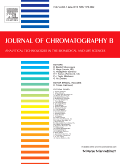
JOURNAL OF CHROMATOGRAPHY B-ANALYTICAL TECHNOLOGIES IN THE BIOMEDICAL AND LIFE SCIENCES
Scope & Guideline
Transforming Biomedical Challenges through Chromatography
Introduction
Aims and Scopes
- Chromatographic Method Development:
The journal emphasizes the development of new chromatographic methods, including high-performance liquid chromatography (HPLC), ultra-high performance liquid chromatography (UHPLC), and gas chromatography (GC), tailored for various applications in biomedical research and life sciences. - Analytical Application in Pharmacokinetics:
A significant focus is placed on the pharmacokinetic studies of drugs, where chromatographic techniques are utilized to quantify drug concentrations in biological matrices, aiding in therapeutic drug monitoring and clinical studies. - Metabolomics and Profiling:
The journal explores the application of chromatographic techniques in metabolomics, providing insights into metabolic pathways and biomarker discovery, which are crucial for understanding disease mechanisms and treatment effects. - Environmental and Food Safety Analysis:
Research related to the analysis of contaminants, pesticides, and residues in food and environmental samples is a key area, showcasing the application of chromatography for ensuring safety and compliance. - Innovative Extraction Techniques:
The journal also highlights novel sample preparation and extraction techniques that enhance the sensitivity and specificity of chromatographic analyses, thereby improving overall analytical performance.
Trending and Emerging
- Integration of Mass Spectrometry:
There is a significant trend towards coupling chromatographic techniques with mass spectrometry (MS), particularly in LC-MS/MS applications. This integration enhances sensitivity and specificity for a wide range of analytes in biological and environmental samples. - Focus on Metabolomics:
Metabolomics is increasingly becoming a central theme, with studies exploring metabolic profiles related to various diseases and therapeutic interventions. This trend underscores the importance of understanding metabolic changes in health and disease. - Advanced Sample Preparation Techniques:
Emerging methodologies in sample preparation, such as solid-phase microextraction (SPME) and deep eutectic solvent extraction, are gaining traction. These techniques improve extraction efficiency, reduce solvent usage, and enhance the overall analytical workflow. - Nanotechnology Applications:
The use of nanomaterials in chromatography, particularly for the development of novel stationary phases and sorbents, is on the rise. This trend reflects the ongoing pursuit of improved separation efficiency and selectivity. - Environmental and Food Safety Research:
There is an increasing focus on the analysis of food safety and environmental contaminants, driven by regulatory demands and public health concerns. This trend emphasizes the need for robust analytical methods to ensure compliance and safety.
Declining or Waning
- Traditional Chromatography Techniques:
There is a noticeable decrease in publications focusing solely on traditional chromatography methods without innovative adaptations. As the field evolves, researchers are increasingly adopting more advanced techniques such as UHPLC and LC-MS/MS. - Basic Analytical Techniques in Environmental Monitoring:
While environmental monitoring remains important, the focus on basic analytical techniques without the integration of advanced methodologies appears to be declining, as researchers seek more sophisticated approaches for complex sample matrices. - Pharmacodynamics Studies:
Research specifically targeting pharmacodynamics, as opposed to pharmacokinetics, has become less frequent. The emphasis has shifted towards more comprehensive pharmacokinetic studies that include metabolomics and pharmacogenomics.
Similar Journals

CHROMATOGRAPHIA
Advancing the Frontiers of Chromatographic ScienceCHROMATOGRAPHIA is a renowned scholarly journal published by Springer Heidelberg, specializing in the field of analytical chemistry, biochemistry, and organic chemistry since its inception in 1968. With its ISSN 0009-5893 and E-ISSN 1612-1112, the journal has maintained a robust profile, currently ranking in the Q3 and Q4 quartiles within significant Chemistry categories. Aimed at researchers, professionals, and students, CHROMATOGRAPHIA serves as a critical platform for disseminating innovative research, methodologies, and advancements related to chromatography and its applications in various scientific fields. While the journal is not open access, it offers significant visibility and scholarly contribution opportunities, making it an essential resource for those engaged in the vibrant intersection of chemistry and biochemistry.

JPC-JOURNAL OF PLANAR CHROMATOGRAPHY-MODERN TLC
Connecting Researchers to Cutting-Edge TLC Insights.JPC-JOURNAL OF PLANAR CHROMATOGRAPHY-MODERN TLC, published by Springer Heidelberg, is a pivotal resource in the fields of Analytical Chemistry, Biochemistry, and Clinical Biochemistry. With an ISSN of 0933-4173 and an E-ISSN of 1789-0993, this journal serves as an essential platform for the dissemination of innovative research on planar chromatography techniques, specifically modern thin-layer chromatography (TLC). With its upcoming coverage extending to 2024 and a third quartile ranking (Q3) across major scientific categories in 2023, it addresses the critical advancements and applications in analytical methods. Although it does not offer open access, the journal's rigorous peer-review process ensures high-quality findings that contribute to the progression of these vital scientific disciplines. The journal is located in Heidelberg, Germany, and continues to be a beacon for researchers, professionals, and students who seek to enhance their knowledge and practice in chromatographic techniques.

BUNSEKI KAGAKU
Cultivating Knowledge in Analytical Chemistry Since 1952BUNSEKI KAGAKU, published by the Japan Society Analytical Chemistry, is a reputable journal dedicated to the field of analytical chemistry. With an ISSN of 0525-1931, this journal has been a crucial outlet for scholarly communication since its inception in 1952, converging its publication years from 1954 to 1957 and from 1959 to 2024. Although it holds a Q4 category ranking in the most recent 2023 quartiles of analytical chemistry and ranks 153/156 in Scopus, it continues to serve as a platform for quality research, fostering advancements in the field. BUNSEKI KAGAKU is based in Tokyo, Japan, and emphasizes the critical importance of analytical techniques in scientific inquiry. With a commitment to professionalism and rigor, the journal provides a vital resource for researchers, students, and professionals seeking to explore innovative methodologies and contribute to the ongoing dialogue in analytical chemistry.
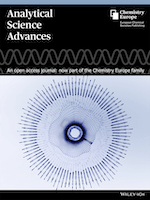
Analytical Science Advances
Leading the Charge in Analytical Method DevelopmentAnalytical Science Advances is a dynamic journal published by WILEY, dedicated to the ever-evolving field of analytical chemistry. With an ISSN of 2628-5452, this open-access platform aims to disseminate high-quality research and insightful reviews that push the boundaries of analytical methodologies and instrumentation. Since its inception in 2020, the journal has gained traction, securing a commendable Q2 ranking in 2023 within its category, highlighting its significance in the scientific community. Currently positioned at Rank #68 out of 156 in Scopus' analytical chemistry category, it boasts a 56th percentile ranking, reflecting its contributions to advancing analytical techniques. Researchers, professionals, and students will find this journal an invaluable resource for keeping abreast of the latest developments, emerging technologies, and innovative approaches in analytical science, ensuring the journal's relevancy and influence in shaping future discoveries.

JOURNAL OF ANALYTICAL CHEMISTRY
Empowering Researchers in Analytical ExcellenceJOURNAL OF ANALYTICAL CHEMISTRY, published by PLEIADES PUBLISHING INC, stands as a pivotal resource in the field of analytical chemistry, offering an innovative platform for researchers, professionals, and students to advance their knowledge and contribute to the discourse within the discipline. With an ISSN of 1061-9348 and an E-ISSN of 1608-3199, this journal features a focused exploration of analytical methodologies, instrumentation developments, and applications across various domains, contributing to practical and theoretical advancements in the field. Currently ranked in the Q3 category in Analytical Chemistry with a Scopus rank of #111 out of 156, it provides critical insights and innovation strategies for professionals aiming to enhance their analytical capabilities. Access to the journal is through standard subscription models, and it covers an extensive range of topics pertinent to the discipline from 1996 to 2024. Engage with the JOURNAL OF ANALYTICAL CHEMISTRY to be part of a vibrant research community dedicated to push the boundaries of analytical practices.
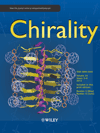
CHIRALITY
Connecting Researchers to the Heart of Chiral StudiesCHIRALITY is a prominent journal in the field of chemistry, published by Wiley. Established in 1989, it has become a critical resource for researchers and professionals interested in the intricate study of chiral compounds across various applications, including analytical chemistry, catalysis, drug discovery, organic chemistry, pharmacology, and spectroscopy. With an ISSN of 0899-0042 and an E-ISSN of 1520-636X, CHIRALITY currently holds a Q2 ranking in Analytical Chemistry and Q3 rankings in several other categories based on the latest assessments. Although it does not offer open access, the journal is widely recognized for disseminating high-quality research that contributes significantly to our understanding of chirality. Its impact is reflected in its Scopus rankings, indicating the journal's influence and relevance within the broader scientific community. Researchers, students, and professionals alike will find CHIRALITY an invaluable conduit for cutting-edge findings and developments in chirality-related research.
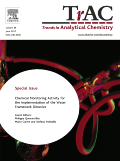
TRAC-TRENDS IN ANALYTICAL CHEMISTRY
Advancing Knowledge in Analytical ChemistryTRAC - Trends in Analytical Chemistry is a prestigious journal published by Elsevier Science Ltd, situated in the Netherlands. With an impressive impact factor reflected in its Q1 rankings across three major categories—Analytical Chemistry, Environmental Chemistry, and Spectroscopy—this journal stands at the forefront of disseminating pioneering research and advancements in the field of analytical chemistry. Established in 1981, TRAC provides a comprehensive platform for researchers to share influential studies and insights related to the latest trends, methodologies, and technologies in analytical techniques. Recognized globally, the journal excels in fostering cross-disciplinary dialogue and innovation, making it an indispensable resource for academics, professionals, and students alike. Explore the latest issues to stay abreast of cutting-edge developments that shape the analytical sciences.

Analytical and Bioanalytical Chemistry Research
Exploring Innovations in Chemical Analysis.Analytical and Bioanalytical Chemistry Research is an esteemed open-access journal published by the Iranian Chemical Society, dedicated to the advancement of knowledge in the fields of analytical chemistry, biochemistry, and spectroscopy. Since its inception in 2014, this journal has provided a platform for researchers, professionals, and students to publish and access high-quality research articles that contribute to the understanding of chemical analysis and bioanalytical methods. With an ISSN of 2383-093X and an open-access model that promotes global dissemination of findings, it ensures that innovative research reaches a broad audience. The journal has consolidated its presence in the scientific community, currently ranked in quartile Q4 for analytical chemistry, biochemistry, and spectroscopy as of 2023. Its Scopus rankings, including a percentile of 34th in Analytical Chemistry, reflect its commitment to quality research and scholarly contribution. Situated in Tehran, Iran, the journal serves as a vital resource for academic discourse, offering insights into emerging trends and methodologies in analytical and bioanalytical chemistry.

LCGC EUROPE
Connecting researchers to the pulse of chromatographic advancements.LCGC EUROPE is a prominent journal dedicated to the field of analytical chemistry, specifically highlighting the latest trends and innovations in chromatographic techniques. Published by MJH Life Sciences, this journal has served as a valuable resource for researchers, professionals, and students interested in the nuances of laboratory practices and the advancement of instrumentation. Although LCGC EUROPE ceased its coverage in Scopus from 2018, it has maintained a significant influence within the community, evidenced by its Scopus rank of 90/114 in Analytical Chemistry, placing it in the 21st percentile. With its inception dating back to 1996, the journal provided essential insights and peer-reviewed articles, fostering a rich understanding of chromatographic science. While the journal is not currently open access, it remains an integral part of the literature for anyone engaged in the analytical chemistry landscape, especially as it pertains to laboratory methodologies and innovations.
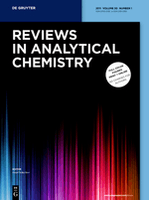
REVIEWS IN ANALYTICAL CHEMISTRY
Unlocking Insights in Analytical MethodologiesREVIEWS IN ANALYTICAL CHEMISTRY, published by De Gruyter Poland Sp. z o.o., serves as a pivotal resource in the field of analytical chemistry, with a notable impact factor indicative of its scholarly significance. As an Open Access journal since 2020, it ensures widespread dissemination of high-quality research articles, facilitating knowledge sharing among researchers, professionals, and students alike. With its origins tracing back to 1980, the journal has adeptly adapted over the years to encompass emerging trends and innovations within analytical methodologies, maintaining its relevance and authority in the discipline. The journal is ranked in the Q2 category of analytical chemistry in 2023 and holds a commendable Scopus rank of #32 out of 156, reflecting its strong performance and the quality of the studies published. Researchers looking for cutting-edge reviews and insights will find this journal an invaluable platform for advancing their knowledge and research in analytical chemistry.